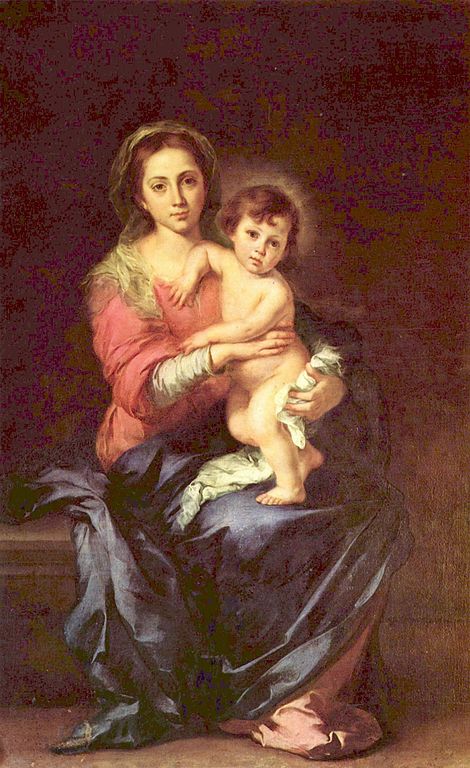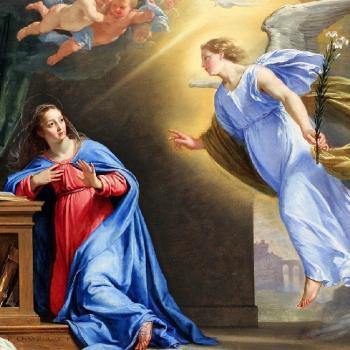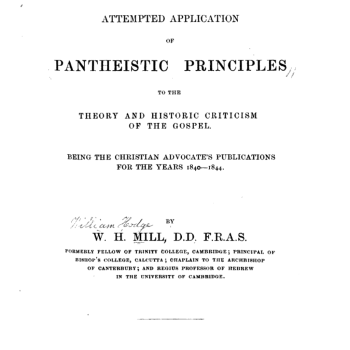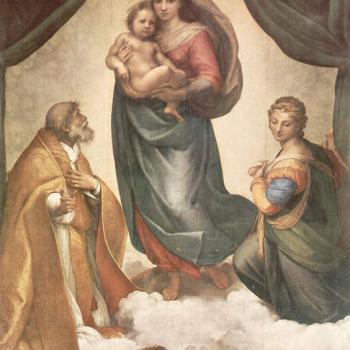Madonna and Child (c. 1655-1660), by Bartolomé Esteban Murillo (1617-1682) [public domain / Wikimedia Commons]
* * * * *
I wrote a very extensive paper about this entire issue, entitled, Mary’s Perpetual Virginity “In Partu” (a Miraculous, Non-Natural Childbirth) is a Binding Catholic Dogma. As part of that, I cited relevant dogmatic statements of the Church, from the newest edition of Denzinger’s Enchiridion symbolorum: Compendium of Creeds, Definitions, and Declarations on Matters of Faith and Morals (Ignatius, 2012), in both English and Latin. This work was co-edited and co-translated by a good friend of mine, fellow Michigander, and great orthodox Catholic scholar, Dr. Robert Fastiggi.
Dr. Fastiggi is also co-editor and co-translator of a revised version of the great dogmatic work, Fundamentals of Catholic Dogma, by Dr. Ludwig Ott [see also a sizable online sample]. That is due to be published by the end of 2015. Dr. Ott was in error on this point of dogma in his 1952 edition (see pp. 205-206). Dr. Fastiggi informed me that Ott responded to warnings from the Holy Office in 1960 and the reiteration of the traditional doctrine by Vatican II (1962-1965), retracted his earlier opinion in 1969 and revised this section, which will be included in the new upcoming edition. Today he sent me the revised version of the section under consideration.
Here is Ott’s 1952 version of the section in question:
Virginity During the Birth of Jesus
Mary bore her Son without any violation of her virginal integrity.
(De fide on the ground of the general promulgation of doctrine.)
The dogma merely asserts the fact of the
continuance of Mary’s physical virginity without
determining more closely how this is to be
physiologically explained. In general the Fathers
and the Schoolmen conceived it as non-injury to
the hymen, and accordingly taught that Mary
gave birth in miraculous fashion without
opening of the womb and injury to the hymen,
and consequently also without pains (cf. S. th.
III 28, 2).
However, according to modern natural scientific
knowledge, the purely physical side of virginity
consists in the non-fulfilment of the sex act
(“sex-act virginity”) and in the non-contact of
the female egg by the male seed (“seed-act
virginity”) (A. Mitterer). Thus, injury to the
hymen in birth does not destroy virginity, while,
on the other hand, its rupture seems to belong to
complete natural motherhood. It follows from
this that from the concept of virginity alone the
miraculous character of the process of birth
cannot be inferred, if it cannot be, and must not
be derived from other facts of Revelation. Holy
Writ attests Mary’s active role in the act of birth
(Mt. I, 25; Luke 2, 7: “She brought forth”)
ThS 572 The Church in Consummation / Collection of Readings, 148
which does not seem to indicate a miraculous
process.
But the Fathers, with few exceptions, vouch for
the miraculous character of the birth. However,
the question is whether in so doing they attest a
truth of Revelation or whether they wrongly
interpret a truth of Revelation, that is, Mary’s
virginity, from an inadequate natural scientific
point of view. It seems hardly possible to
demonstrate that the dignity of the Son of God
or the dignity of the Mother of God demands a
miraculous birth.
Mary’s virginity during the birth of Jesus was
contested in the Early Church by Tertullian (De
carne Christi 23) and especially by Jovinian, an
opponent of the Church ideal of virginal purity ;
and in modern times by Rationalists (Harnack
calls it: “a Gnostic invention”).
Jovinian’s teaching (virgo concepit, sed non
virgo generavit) was rejected at a Synod at
Milan (390) under the presidency of St.
Ambrose (cf. Ep. 42), which recalled the
invocation of the Apostles’ Creed: Natus ex
Maria virgine. Her virginity during the birth of
Jesus is included in the title of honour “perpetual
virgin” (aeiparthenos), which was given to Mary
by the Fifth General Council at Constantinople
(553) (D 214, 218. 227). The doctrine is
expressly taught by Pope St. Leo I in the
Epistola Dogmatica ad Flavianum (Ep. 28, 2)
which was approved by the Council of
Chalcedon; it was taught also by the Lateran
Synod (649) and by Pope Pius IV (1555) (D
256, 993). Pope Pius XII in the Encyclical
“Mystici Corporis” says : “It was she who gave
miraculous birth to Christ our Lord (mirando
partu edidit ).” The Church’s general teaching is
expressed in her Liturgy also. Cf. the
Responsorium to the fifth Lesson of the Feast of
Christmas, and to the eighth Lesson of the Feast
of the Circumcision of Our Lord.
Is. 7. 14 announces that the maiden (as a virgin)
would give birth. The Fathers also, in a typical
sense, refer to the virgin birth of Our Lord the
words of the Prophet Ezechiel on the closed
gates (Ez. 44, 2; cf. St. Ambrose Ep. 42, 6; St.
Jerome, Ep. 49, 21); the words of the Prophe
Isaias on the painless birth (Is. 66, 7; cf. St.
Irenaeus, Epis. 54; St. John Damascene, De fide
orth. IV 14): and the words of the Song of Songs
on the closed garden and the scaled well (Hl. 4,
12; cf. St. Jerome, Adv. Jov. I 31. Ep. 49, 21).
St. Ignatius of Antioch characterises, not merely
Mary’s virginity, but also the bringing forth of
her Son as a “mystery which must be proclaimed
aloud” (Eph. 19, I). Christ’s virginal birth is
accepted without question in the apocryphal
writings of the second century (Odes of
Solomon, 19, 7 et seq.; Proto-Gospel of St.
James 19 et seq ; ascension into heaven of Isaias
11, 7 et seq.), and also by Church authors such
as St. Irenaeus (Epis. 54 ; adv. haer. III 21, 4–6)
; St. Clement of Alexandria (Strom. VII 16, 93) ;
Origen (In. Lev. hom. 8, 2; otherwise in Luc.
hom. 14). St. Ambrose (Ep. 42, 4–7), St. Jerome
(Adv. Jov. I 31 ; Ep. 49, 21) and St. Augustine
(Enchir. 34) defend the traditional Church
doctrine against Jovinian. For the illustration of
the mystery the Fathers and Theologians employ
various analogues—the emergence of Christ
from the sealed tomb, His going through closed
doors, the penetration of the ray of sun through
glass, the birth of the Logos from the bosom of
the rather, the going out of human thought from
the human spirit.
Christ’s miraculous emergence from the
unimpaired womb of the Virgin Mother finds its
ultimate explanation in the Omnipotence of God.
St. Augustine says : “in such things the whole
ground of the mystery is the might of Him who
permits it to happen” (Ep. 137, 2, 8). Cf. S. th.
111 28, 3.
Dr. Fastiggi noted in his personal letter to me today (which he gave permission to share):
In addition to these revisions, there is also the fact that the earlier English translated the German adjective allgemeinen as “general” rather than “universal.” Although allgemeinen can be translated as “general,” there is a big difference in English between a “general teaching” and a “universal teaching.” The fact that Fr. Ott sees the doctrine of Mary’s virginitas in partu as “de fide” argues in favor of translating allgemeinen Lehrverkündigung as “universal teaching.”
Now here is the revised 1969 version of this portion, translated into English: to be included in the upcoming 2015 edition of the work:
Virginity During the Birth of Jesus
Mary bore her Son without any injury to her virginal integrity. (De fide on the ground of the universal teaching of the doctrine.)
The dogma asserts that the bodily integrity of Mary was not injured in the act of giving birth. Just as in conception so also in giving birth her virginal integrity was preserved. The way and manner by which she gave birth was extraordinary in itself. The precise determination as to how Mary’s virginal integrity persisted in a physical manner in giving birth does not belong to the faith of the Church. In the declarations of the Church’s Magisterium and in the testimony of Tradition it is nevertheless firmly maintained that the virginity in giving birth is distinct from the virginity in conception and is a new factor added to her virginity. The theological explanation brings the bodily non-injury in giving birth into coherence with the freedom from disordered passions.
This freedom had a unique dominion of spiritual power over the bodily organs and the sequence of events. Hence it follows that Mary in giving birth to Jesus was completely active as Sacred Scripture implies (Lk 2, 7). In this way the absence of bodily pains and especially the absence of sexual passions can be taken into account. The bodily non-injury is the material element of the virginity in giving birth, while the absence of sexual passions is the formal element.
Mary’s virginity during the birth of Jesus was contested in the Early Church by Tertullian (De carne Christi 23) and especially by Jovinian, an opponent of the Church’s ideal of virginal purity; and in modern times by Rationalists (Harnack calls it: “a Gnostic invention”).
Jovinian’s teaching (virgo concepit, sed non virgo generavit) was rejected at a Synod at Milan (390) under the presidency of St. Ambrose (cf. Ep. 42), which recalled the invocation of the Apostles’ Creed: Natus ex Maria virgine. Her virginity during the birth of Jesus is included in the title of honour “perpetual virgin” (WWWW), which was given to Mary by the Fifth General Council at Constantinople (553) (DH 422, 427, 437). The doctrine is expressly taught by Pope St. Leo I in the Epistola Dogmatica ad Flavianum (Ep. 28, 2) which was approved by the Council of Chalcedon; it was taught also by the Lateran Synod (649) and by Pope Paul IV (1555) (DH 503, 1880). Pope Pius XII in the Encyclical “Mystici Corporis” says: “It was she who gave miraculous birth to Christ our Lord (mirando partu edidit; n. 110).” The Church’s universal teaching is expressed in her Liturgy also. Cf.
The preface to the Marian feasts (virginitatis gloria permanente) and the Responsorium to the fifth Lesson of the Feast of Christmas (cuius viscera intaca permanent), and to the eighth Lesson of the Feast of the Circumcision of Our Lord (peperit sine dolore).
Is. 7. 14 announces that the maiden (as a virgin) would give birth. The Fathers also, in a typical sense, refer to the virgin birth of Our Lord the words of the Prophet Ezechiel on the closed gates (Ez. 44, 2; cf. St. Ambrose Ep. 42, 6; St. Jerome, Ep. 49, 21); the words of the Prophet Isaiah on the painless birth (Is. 66, 7; cf. St. Irenaeus, Epis. 54; St. John Damascene, De fide orth. IV 14: and the words of the Song of Songs on the closed garden and the sealed well (Song of Songs 4, 12; cf. St. Jerome, Adv. Jov. I 31, Ep. 49, 21).
St. Ignatius of Antioch characterises, not merely Mary’s virginity, but also the bringing forth of her Son as a “mystery which must be proclaimed aloud” (Eph. 19, 1). Christ’s virginal birth is accepted without question in the apocryphal writings of the second century (Odes of Solomon, 19, 7 et seq.; Proto-Gospel of St. James 19 et seq.; The Ascension into Heaven of Isaiah 11, 7 et seq.), and also by Church authors such as St. Irenaeus (Epid. 54; Adv. haer. III 21, 4-6); St. Clement of Alexandria (Strom. VII 16, 93); Origen (In. Lev. hom. 8, 2; otherwise in Luc. hom. 14). St. Ambrose (Ep. 42, 4-7), St. Jerome (Adv. Jov. I 31; Ep. 49, 21) and St. Augustine (Enchir. 34) who defend the traditional Church doctrine against Jovinian. For the illustration of the mystery, the Fathers and Theologians employ various analogies—the emergence of Christ from the sealed tomb, His going through closed doors, the penetration of the ray of sun through glass, the birth of the Logos from the bosom of the Father, the going out of human thought from the human spirit.
Christ’s miraculous emergence from the unimpaired womb of the Virgin Mother finds its ultimate explanation in the Omnipotence of God. St. Augustine says: “in such things the whole ground of the mystery is the might of Him who permits it to happen” (Ep. 137, 2, 8). Cf. S.th. III 28, 2.
* * *
Now here are the English and Latin renderings of the dogmatic statements from Denzinger (2012 edition) having to do with Mary’s in partu virginity. Analysis is provided by Ryan Grant: an expert in Latin and its historic ecclesiastical use. He attended the Franciscan University of Steubenville and is a professional translator (A Small Catechism for Catholics, On the Roman Pontiff), and has been a Latin Instructor at a classical Christian academy (seven years as a Latin teacher). His words will be in blue.
Pope Leo the Great, in his famous letter to Flavian, or Tome (449), that was acclaimed and accepted by the Council of Chalcedon in 451, stated:
. . . the Virgin Mother, who gave birth to him in such a way that her virginity was undiminished. (Denzinger [DS] 291)
. . . quae illum ita salva virginitate edidit, quemadmodum salva virginitate concepit . . .
And:
“. . . his birth was miraculous” (DS 294)
. . . quia nativitas est mirabilis . . .
Letter of Leo to Julianus of Cos, 13 June 449 (Licet per nostros):
. . . he was brought forth from the womb of the Mother in such a way that her fertility gave birth while her virginity remained, . . . (DS 299)
. . . conceptus et natus, sive quod its visceribus matris est editus, ut et fecunditas pareret et virginitas permaneret . . .
Pope Hormisdas Letter Inter ea quae to Emperor Justinian, 26 March 521:
. . . opening the mother’s womb by his birth and yet not damaging the virginity of the Mother by the power of the Godhead. (DS 368)
. . . matris vulvam natus aperiens et virginitatem matris deitatis virtute non solvens.
The profession of faith of Pope Pelagius (AD 557) stated:
[H]e was born preserving the integrity of the Mother’s virginity: since she bore him while remaining a Virgin just as she conceived him as a Virgin. (DS 442)
. . . natum esse, servata integritate maternae virginitatis: quia sic eum Virgo permanens genuit, quemadmodum Virgo concepit.
One cannot remain a virgin in a biological sense if the hymen does not remain intact.
The Lateran Synod of AD 649, presided over by Pope St. Martin I, held that Mary:
gave birth to him without corruption, her virginity remaining equally inviolate after his birth . . . (DS 503)
. . . qui a Deo Patre ante omnia saecula natus est, in ultimis saeculorum absque semine concepisse ex Spiritu Sancto, et incorruptibiliter eam genuisse, indissolubili permanente et post partum eiusdem virginitate . . .
Here is the literal rendering, which is tricky because it uses a delayed antecedent:
“… Who was born from God the Father before all ages, in the last of the ages she conceived [Him] by the Holy Spirit without seed, and she gave birth incorruptibly, with the virginity of the same remaining unbroken even after birth.”
The adjective indissolubilis is the key here. It is the same word as is used to refer to the marital bond. It means imperishable, or something that cannot be untied, or broken. Likewise, the adverb incorruptibiliter which essentially means the same thing. Thus partum in this context is the fourth declension noun, partus, –us, which refers to the act of giving birth. Now someone could strictly point out that partus is not concerned with the hymen, because by the time a woman normally gives birth it is already broken. Yet with the blessed Virgin it is intact, so then partus does in fact involve the hymen, which normally would be broken. So the adjectives and adverbs here are indicating it is not so.
The Eleventh Council of Toledo (AD 675) includes the following doctrine in its Creed:
[36] . . . He was begotten from her in a new order and by a new birth: in a new order, because, invisible in his divinity, he is shown visible in the flesh; by a new birth, because an inviolate virginity, without knowing the contact of man, supplied the matter of his body, being made fruitful by the Holy Spirit. [37] This virgin birth is neither grasped by reason nor illustrated by example. Were it grasped by reason, it would not be wonderful; were it illustrated by example, it would not be unique. (DS 533)
[36] . . . nova autem nativitate est genitus, quia intacta virginitas et virilem coitum nescivit et foecundatam per spiritum Sanctum carnis materiam ministravit. [37] Qui partus Virginis nec ratione colligitur, nec exemplo monstratur; quod si ratione colligitur, non est mirabile; si exemplo monstratur, non erit singulare.
Intacta is the adjective describing virginity, and the translator has understood the sense, inviolate. Moreover, intacta is made up of the antecedent passive participle of tango tangere (to touch), which in Latin may be used to negate a word. Thus intacta has the sense of untouched. Among the standard definitions for this adjective one finds: “virgin”.
The Sixteenth Council of Toledo (AD 693) asserted:
As the Virgin, of course, preserved the purity of virginity before conception, accordingly after birth she experienced no corruption of her integrity; for she conceived as a virgin, she gave birth as a virgin, and after birth, she preserved the purity of incorruption without subtraction. (DS 571)
Quae scilicet virgo sicut ante conceptionem obtinuit virginitatis pudorem, ita post partum nullam sensit integritatis corruptionem; nam virgo concepit, virgo peperit, et post partum incorruptelae pudorem sine interceptione obtinuit.
Here we could say that, integritas, integritatis also means chastity in regard to the quality of a woman’s virginity, not integrity in a generic sense, in that regard it is a bit of a false friend. Thus this passage could read:
“The Virgin, who just as she indeed preserved the purity of virginity before the conception, also after the birth experienced no corruption of chastity; for a virgin she conceived, a virgin she gave birth, and after the birth she preserved the purity of incorruption without interruption.”
Additionally, the phrase “corruption” needs to be understood as it was used in later Latin and by Augustine, as the ceasing of the presence of something. The scholastics pick up on this usage when they speak of the corruption of a vice (meaning it ceases to adhere to the soul) or the corruption of a virtue (again, ceases to be). So when the Council says “without corruption of chastity”, it means without the loss of the wholeness of virginity.
Pope Alexander III: Letter Ex litteris tuis to the resident Sultan in Iconium, 1169: “. . . gave birth without pain, . . .” [“peperit sine dolore”] (DS 748)
In 1555 Pope Paul IV published a bull, Cum quorumdam. It includes this:
[condemning the following] . . . that the same most blessed Virgin Mary is not the true Mother of God and did not always persist in the integrity of virginity, namely, before giving birth, in giving birth, and perpetually after giving birth. (DS 1880)
. . . perstitisse semper in virginitatis integritate, ante partum scilicet, in partu et perpetuo post partum . . .
Here integritas is key again. Above it meant chastity, but here it can be understood more along the line of “integrity”, since chastity is often a synonym for virginity, but here it is used in the connection to the noun “virginity”, to indicate the fullness of virginity in particular, as opposed to meaning virginity in general above for which there was no corruption. That is to say, it is speaking of the particular fullness of virginity (the hymen) whereas above was referring to virginity.














